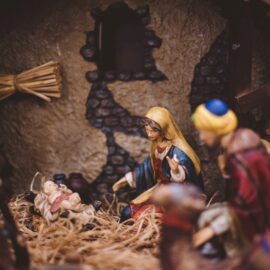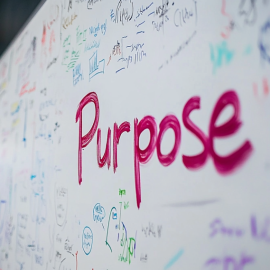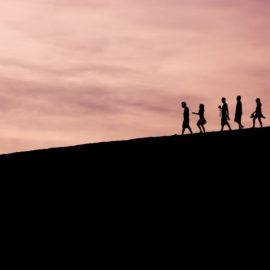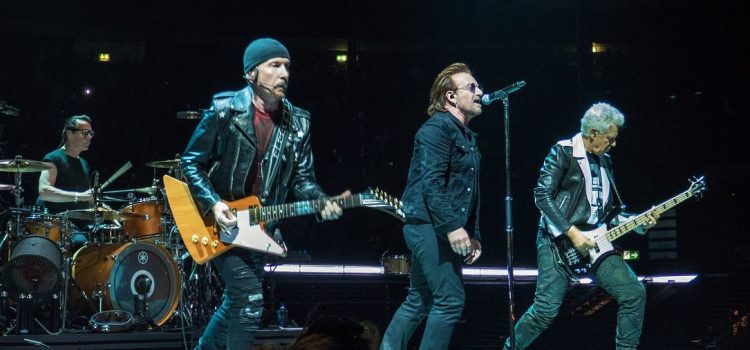
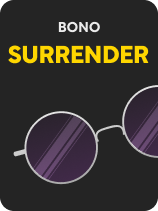
This article is an excerpt from the Shortform book guide to "Surrender" by Bono. Shortform has the world's best summaries and analyses of books you should be reading.
Like this article? Sign up for a free trial here.
Who is in U2? How many members does the group have? Where did “The Edge” get his nickname?
U2 is made of four musicians: Paul “Bono” Hewson, Larry Mullen Jr., David “the Edge” Evans, and Adam Clayton. A look at who is in the band and how they came together gives you a good understanding of what kind of group U2 is.
Read more for some background on each of U2’s four members.
The Band Members
Who is in U2, and how did the band form? The world-renowned musical group U2 began in the kitchen of drummer Larry Mullen’s house, where he auditioned his fellow classmates for spots in his new venture. All four future members of U2 were in that room.
Paul “Bono” Hewson
Paul “Bono” Hewson was born in Dublin, Ireland, on May 10, 1960. Though he was interested in music from a young age, his direction in life was also defined by family trauma and his growing Christian faith. Bono recalls how his childhood was shaped by the death of his mother, his introduction to evangelical Christianity, and the adolescent friendships that would launch him into adulthood.
Bono’s always considered his chief songwriting talent to be finding the primary musical line and highlighting the central message of a song. One example Bono gives is that of “Sunday Bloody Sunday,” which the band wrote as a protest song against Ireland’s political violence. Because Bono feared the song might be co-opted by the rebel groups they were protesting, he’d shout “this is not a rebel song” and rip an Irish flag onstage. While this angered some groups within Ireland, it made the message of the song very clear.
Larry Mullen Jr.
In his memoir Surrender, Bono writes that of all U2’s members, Mullen is the natural “rock star.” From the beginning, Mullen’s drive to make music held their fledgling band together. Mullen learned to play drums for his love of rock music, though his father only encouraged him in the hopes that one day he’d switch to jazz. According to Bono, Mullen has always been the most cautious and protective member of U2, and Mullen’s mother served as the band’s surrogate mom until her death in a car accident in 1976. Since then, Bono has felt that his and Mullen’s shared loss of a parent is one of the things that ties them together.
Mullen studied under the Irish drummer Joe Bonnie and—after his death—his daughter Monica. Apart from losing his mother, just like Bono, Mullen has had other struggles in life. He lost his younger sister Mary in 1973, and he’s had to deal with the physical toll that drumming has taken on his body. Drums are physically challenging to play, and drummers are prone to repetitive motion injuries, such as those that forced Mullen to take a break from the band during its 2023 Las Vegas residency. Recognizing that such injuries affect all drummers and appreciating the care he’d received, Mullen joined the board of the Steadman Clinic, an institution for researching treatments in orthopedic and sports-related injuries.
The Edge
Like Bono, David “the Edge” Evans would also be saddled with a childhood nickname for life. Bono says that right away, Edge was the coolest member of the group, with his Zen-like way of keeping his emotions on an even keel. He played guitar better than Bono, and as the band eventually gelled, it was Edge who’d stand up to Bono’s fits of artistic pique. Edge was highly religious, to the point that at one time, he considered leaving the band to pursue a calling in the church. He found musical inspiration from Christian hymns that would show up in many of U2’s songs, most notably the gospel-infused “I Still Haven’t Found What I’m Looking For.”
Edge recalls that his nickname started because of the shape of his chin. Among rock guitarists, Edge creates a distinctive sound using pedal effects, a digital echo, and finely tuned audio feedback. His sound stands out particularly clearly on the guitar track for “Where the Streets Have No Name.” Following the destruction of New Orleans by Hurricane Katrina, Edge founded Music Rising to rebuild the city’s musical culture and those of other places struck by natural disasters. Though a practicing Protestant, in 2016, Edge became the first rock guitarist to perform in the Sistine Chapel at the Vatican.
Adam Clayton
In many ways, bassist Adam Clayton is the odd man out in the group. English-born and not actively religious, Clayton was a “posh” outsider when he arrived at the school they all jointly attended. Bono recalls that out of them all, Clayton most believed in their eventual success, and it was one of Clayton’s friends in the Irish punk scene who suggested the band’s eventual moniker, named after the U-2 reconnaissance aircraft. Bono declares that Clayton was by far the most worldly and fashionable among them, though Clayton would also become the only member to suffer from substance abuse problems, which would take a toll on him later in life.
While Mullen may have started U2 by putting out the initial call for auditions, it was Clayton who booked their early concerts and negotiated on behalf of the band in dealings with CBS Records’ Irish division. In his book, Bono gives an outsider’s perspective on Clayton’s struggles with alcohol abuse, but in 2023, Clayton revealed his problems with depression, which he kept secret from the people around him while using alcohol as a means to cope. Like Edge, Clayton plays with a distinctive, driving sound, heard on such songs as “With or Without You,” which is now featured in a custom bass amp from Fender built to Clayton’s specifications.

———End of Preview———
Like what you just read? Read the rest of the world's best book summary and analysis of Bono's "Surrender" at Shortform.
Here's what you'll find in our full Surrender summary:
- The memoir of Irish rockstar Bono, and the band U2
- How Bono balanced fame with fatherhood, marriage, and religion
- How Bono used his fame to become a voice for activist groups

